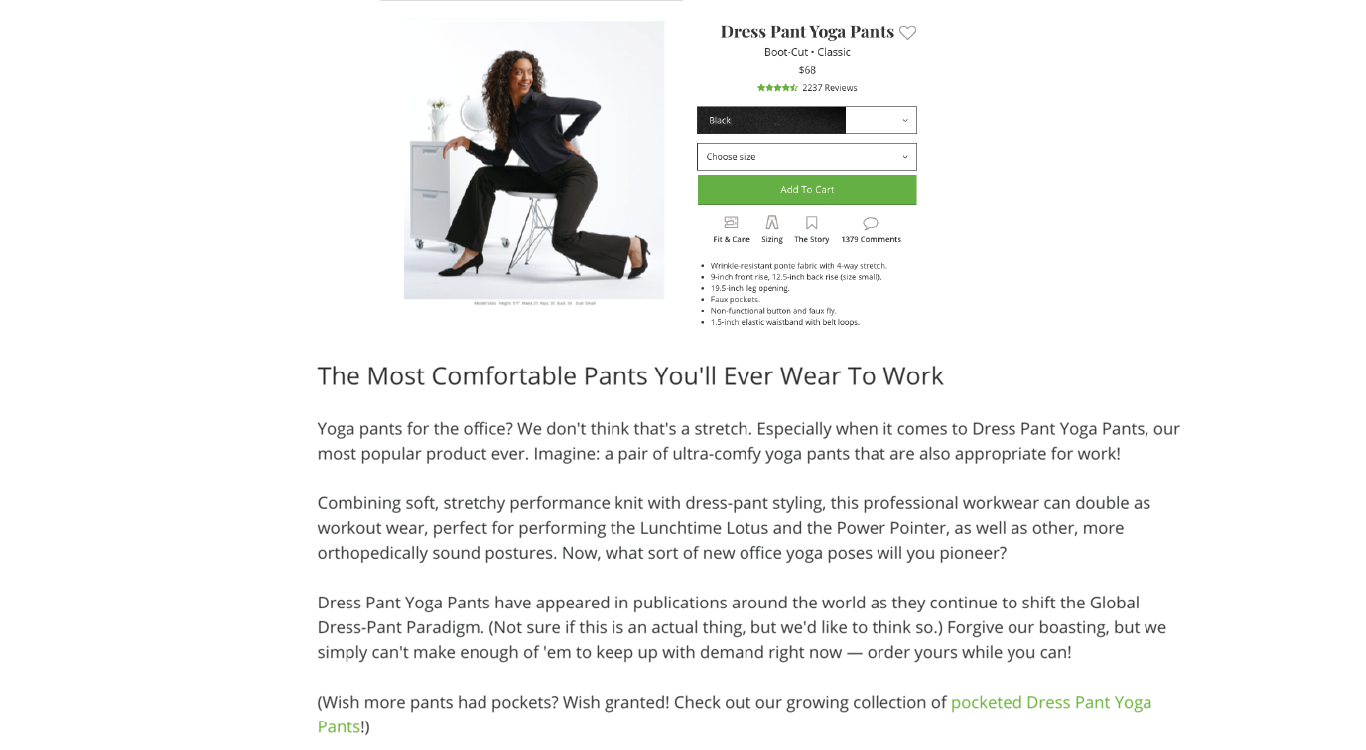The new, post-pandemic frontier of customer centricity: Agile Product Storytelling
Executive Summary
Community, convenience or irrelevance
Thanks to the pandemic, the future of e-commerce arrived 10 years early. Brands hoping to sell online must quickly choose between the two dominant e-commerce models or risk irrelevance:
- The marketplace model that optimizes on convenience by selling the widest selection of products to the widest audience at the lowest possible prices (including shipping and returns).
- The direct to consumer model that optimizes on community by focusing on a curated selection of products and experiences perfectly tuned to a valuable, well-defined community who share common beliefs, values and interests.
Brands that don’t choose one of these two models will be caught in the “mushy middle.” Lacking the ability to build community like a digital native DTC brand or deliver the convenience of a marketplace, they’ll find it very difficult to attract customers and generate revenue in the post-pandemic world.
Storytelling is the rock DTC success is built upon
The core strategy DTC pioneers like Glossier and Rapha used to build community and escape the mushy middle is storytelling. The story-and-response feedback loop they created with their customers goes beyond marketing and informs every decision they make, from product development to packaging and distribution.
But the world now understands the power of storytelling and the ranks of DTC brands are exploding. Storytelling is no longer a differentiator. It’s table stakes for modern brands. To stand out from the crowd, brands need to pioneer new and deeper ways to connect with their customers online. Agile product storytelling represents the next wave of DTC customer centricity.
Agile product storytelling turns one-way stories into two-way conversations
The goal of the DTC model is to use digital tools to scale the customer-centric experience of the small, specialty retailer to a global audience. Your product page must duplicate the friendly, knowledgeable conversation customers expect from a sales associate. It should be able to adapt its story based on the customer, the context and the product.
Agile product storytelling optimizes the customer experience through data-driven product storytelling. It creates a real time feedback loop with shoppers—using their own data, reviews and feedback—so you can always be sure you’re telling the right story to the right customer at the right time. The result is higher conversion, greater loyalty and higher lifetime value.
Over the last decade, consumer demand has been steadily shaping e-commerce into two distinct and polar opposite experiences: one built on convenience, the other built on community. The Covid crisis has kicked this transformation into warp drive. Retailers who’ve positioned themselves at either of these two extremes are surviving—and even thriving—in the current crisis. But the pandemic and its economic aftermath have become a moment of reckoning for retailers caught between these two extremes.
The new, post-pandemic frontier of customer centricity: Agile product storytelling
01 Why agile product storytelling?
Over the last decade, consumer demand has been steadily shaping e-commerce into two distinct and polar opposite experiences: one built on convenience, the other built on community. The Covid crisis has kicked this transformation into warp drive. Retailers who’ve positioned themselves at either of these two extremes are surviving—and even thriving—in the current crisis. But the pandemic and its economic aftermath have become a moment of reckoning for retailers caught between these two extremes.
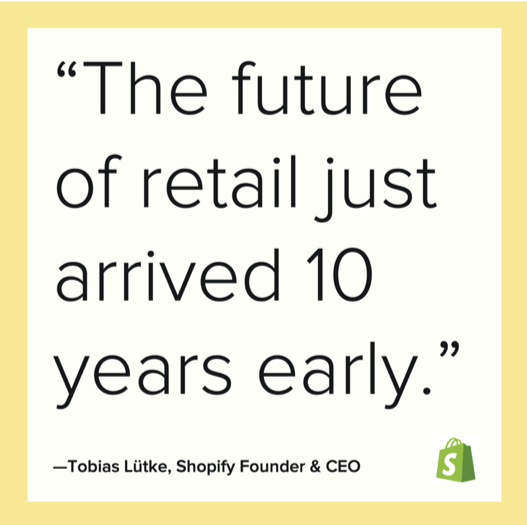
Marketplaces: Convenience, price, selection
Marketplaces like Amazon, Walmart and Target are gobbling up market share by pushing the limits of convenience. The promise of vast product selections, low perceived prices and frictionless shipping & returns draw millions of convenience-minded shoppers to them. Their massive scale allows these retail behemoths to invest in vast supply chains and tech infrastructures that will secure their market dominance for the foreseeable future.
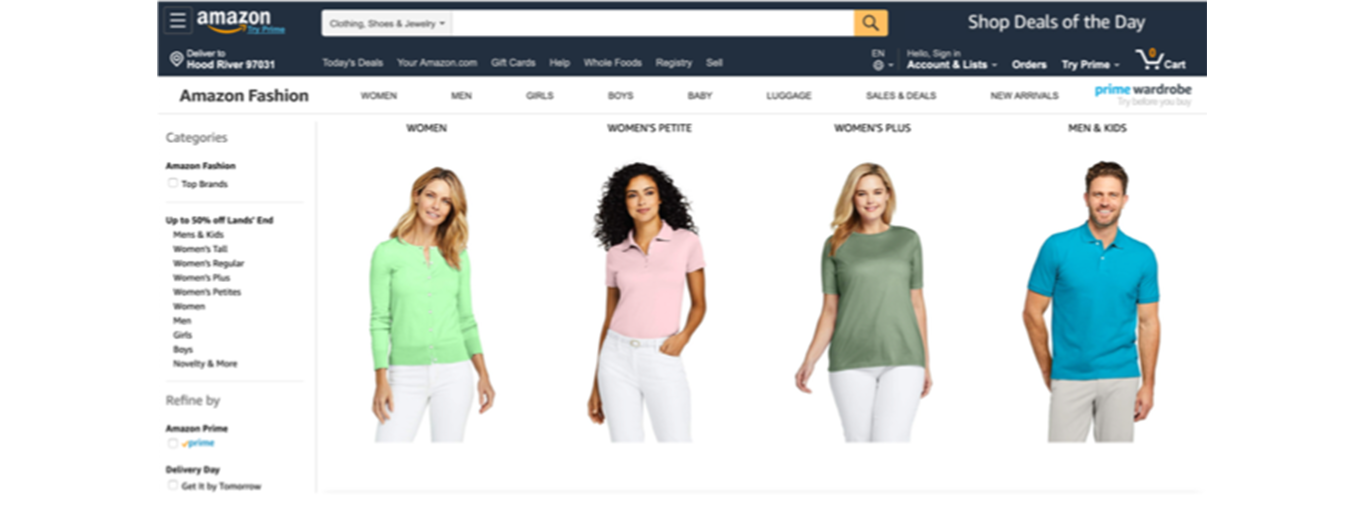
Direct to Consumer: Community, curation, content
The countervailing extreme to the marketplace model are the thousands of digital native brands who put community-building first and selling second. This model has found its truest expression in digital native vertical brands (DNVBs) such as Glossier, Shinola and Rapha. But there are also many brands like Huckberry, Backcountry.com, Net-a-porter and Cotopaxi that aren’t true DNVBs, but have seen great success with this same community-centered model.
Whether a pure-play DNVB or hybrid, these brands win by doing what’s impossible for Amazon: focusing on a curated selection of products and experiences perfectly tuned to a valuable, well-defined community who share common beliefs, values and interests.

Direct to consumer success: continually optimize for community, content and curation.
The Mushy Middle
Between these two extremes are where many e-commerce retailers struggle for customers and revenue. They’re trapped in what Bayard Winthrop, founder of American Giant, has labeled the “mushy middle.” They lack the rabid community of followers that power the success of the DNVBs, yet can’t match the price and convenience of the marketplaces. This middle ground has always been a tenuous place to establish a profitable business. But thanks to the pandemic’s stranglehold on the consumers’ pocketbooks, it’s become a death trap.
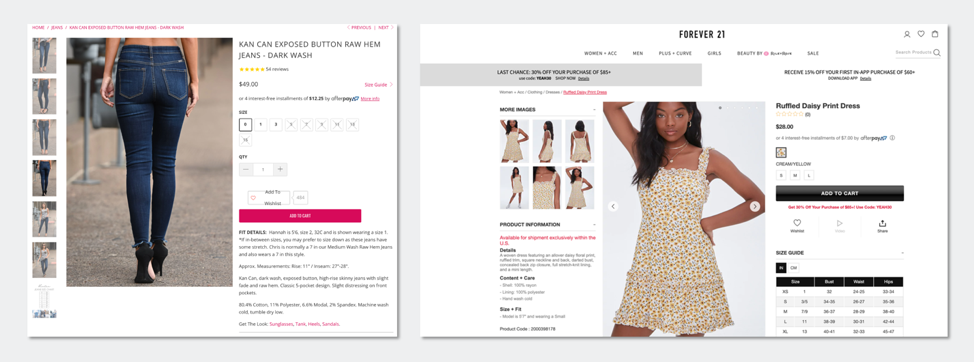
This is where most legacy retailers currently find themselves. But it’s not just legacy competitors who will struggle and ultimately fail to escape the mushy middle. Digital native retailers that rely solely on tactical mastery of the online channel are beginning to suffer the same fate as their legacy counterparts. Digital mastery can help a brand break into a crowded market segment full of digital-laggard competitors. But it isn’t enough to build a sustainable e-commerce business upon.

Storytelling: Escape from the mushy middle
When Glossier founder Emily Weiss proclaimed back in 2014 that “content is at the heart of everything we do at Glossier” it was a wakeup call to digital retailing world. At the time, most retailers thought content and storytelling were just clever new ways to describe the standard marketing tactics everyone was already practicing.

What very few understood back then was how fundamental storytelling actually was to DTC success. The story-and-response feedback loop a DTC brand creates with its customers has the power to drive every decision it makes—from product development and packaging to editorial calendars and distribution models.
Without storytelling you can’t gather a core community of early adopters. Without that core community, you have no one to take the leap and try your newest products, provide feedback and spread your gospel. A continuous stream of fresh content and products focused around a strong point of view also gives your community a reason to return to your store and engage with your brand over and over again throughout the year.
“The inherent promise of the DNVB model is…to offer a buying experience as memorable as the product. Content is specialized and created by experts allowing for a more pertinent conversation with each visitor.”
— Camille Kriebitzsch, Principal & cofounder of DTC VC firm, Eutopia
Storytelling once set DTC leaders apart. Now it’s simply a cost of community.
Now it’s 2020 and Emily’s words no longer sound like a revelation. They sound more like a simple statement of fact. Every successful DTC retailer now understands that the affluent, influential young shoppers that makeup the core of any DTC customer base don’t buy ‘what you make,’ they buy ‘why you make it.’ If you gain their trust, you gain their loyalty. And the content your brand generates is the rock that trusted relationship is built upon.
Ever since pioneering brands like Glossier, Rapha and Shinola cracked the DTC business model, the field of competitors has exploded. And thanks to the rapidly-dropping cost of entry, it’s getting more crowded by the day. There are currently over 1,000,000 stores selling on the Shopify platform alone. Consumers have never had more choice across every product category. And they’re consistently choosing the brands that can deliver ever greater levels of empathy, trust and customer centricity.
The new frontier of customer centricity: Agile product storytelling
Agile product storytelling (APS) is an approach to customer centricity that even the fastest-moving brands have yet to fully master. APS is simply doing on the product page what leading DTC brands do so well everywhere else in their business: continually optimize the customer experience through data-driven insights.
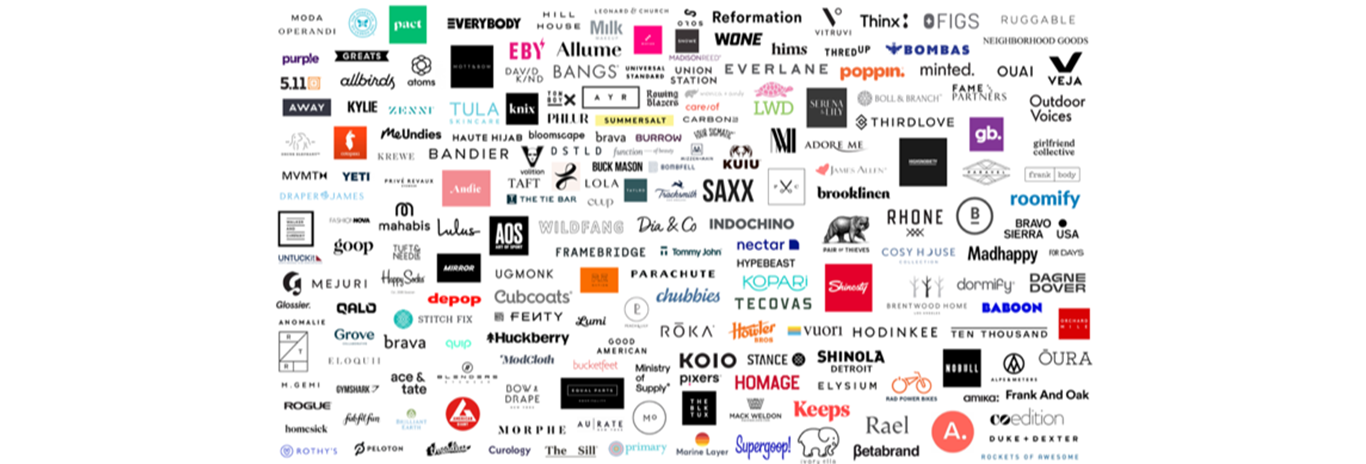
“Moving forward, brands and retailers must explore even more creative ways to demonstrate value and engage through experiential means to woo younger customers and maintain customer loyalty, particularly in light of the challenging retail climate.”
– Lauren Freedman, President of the e-tailing group
When product storytelling breaks down: Betabrand
SOCIAL CHANNELS:
Their social team has adapted their story to reflect customers’ new stay-at-home-reality.

PRODUCT PAGE:
But their product page, continues to tell a tone-deaf story about how Betabrand can’t keep up with demand of a product designed for a world of office work that no longer exists.
RESULTS:
Does this disconnect represent fatal breach of consumer trust? Certainly not. Will it suppress converted visits by double digits and weaken customer trust? Without a doubt.

APS turns stories into conversations
The north star of the direct to consumer experience is to duplicate online the care, knowledge and attention of a local specialty retailer. If you were to walk through the door of a running specialty shop in mid-summer, for instance, and inquire about a long sleeve running shirt, no sales associate in their right mind would begin by telling you how well the shirt performs on frigid winter runs. They would adjust their story about the product on the fly given a myriad of factors including seasonality, economic climate and customer persona.
“In an age where consumers do a lot of research on the items they want to buy, it’s necessary for a brand’s website to be as effective as a salesperson at a store.”
– Lauren Freedman, President of the e-tailing group
A DTC product page should approximate that one-on-one conversational experience. When customers read a product story, it should feel like the brand knows who they are and why they arrived at that product page that day. By adapting your product stories to be more in tune with your customer’s current wants and needs, APS turns your product page into a much more responsive and effective sales tool.
APS: A higher return on story
The all-in cost of producing a single well-crafted, consumer-centric product story should easily pencil out to less than $100 for any brand. In other words, the investment only needs to increase the sales of each product by two or three units to cover the investment.
More likely, your return on investment will be closer to the 20% increase in conversion rate Nielsen Norman Group were able to generate in their study of online purchase behavior. No matter how many additional product stories you create throughout the year, the investment will always pale in comparison to the return.

There is no better investment you can make than crafting accurate, engaging and relevant product page content.
02 Putting it all together
Product, Consumer, Context: The three levers of Agile product storytelling
When most people think of the product page they think of product information. But the product is only one factor to consider when crafting a high-converting product story. To make sure you’re telling the right product story to the right customer at the right time you must also consider 1) your target consumer and, 2) the purchase context. By leveraging all three—product, consumer and context—you’re able to turn dry product descriptions that explain into interesting, relevant product stories that convert.
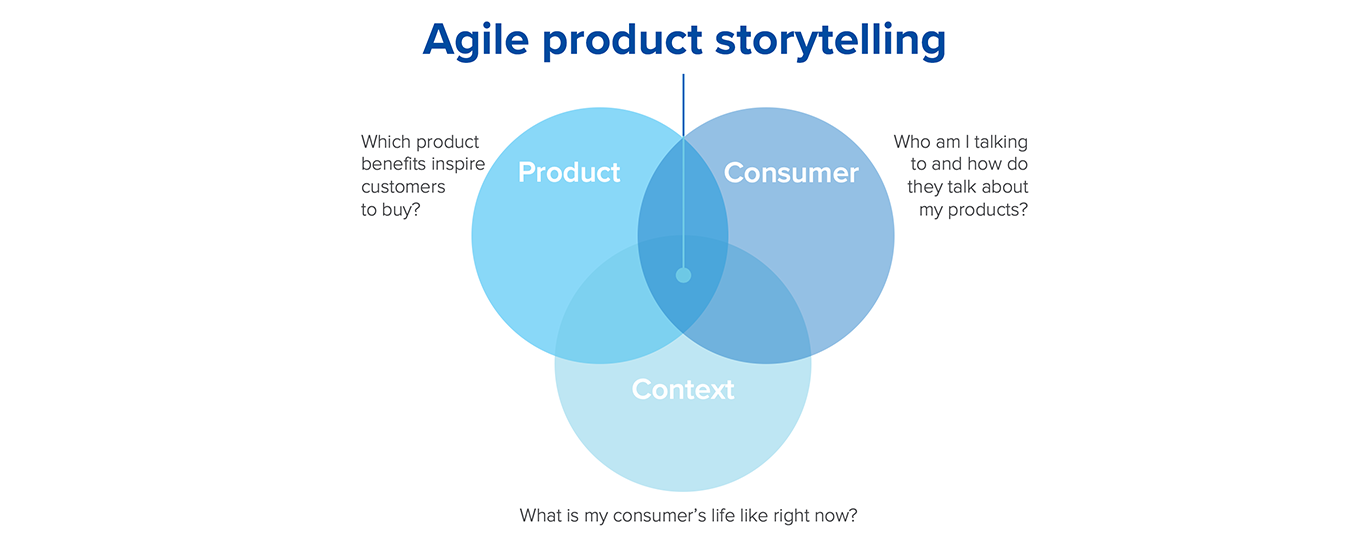
The consumer: Make sure you’re telling the right story to the right shopper
Different consumer types will buy the same product for very different reasons. And those differing reasons almost always require differing product stories. If you sell your products in your own channels as well as on Amazon, for example, you might find very little overlap between the customers who buy through those two channels.
Customers who shop on a snowboard brand’s own DTC website usually do so because they’re familiar with the category and trust the brand. These customers are likely to be deeply immersed in snowboard culture and they’re more comfortable with snowboard language, references and terminology.
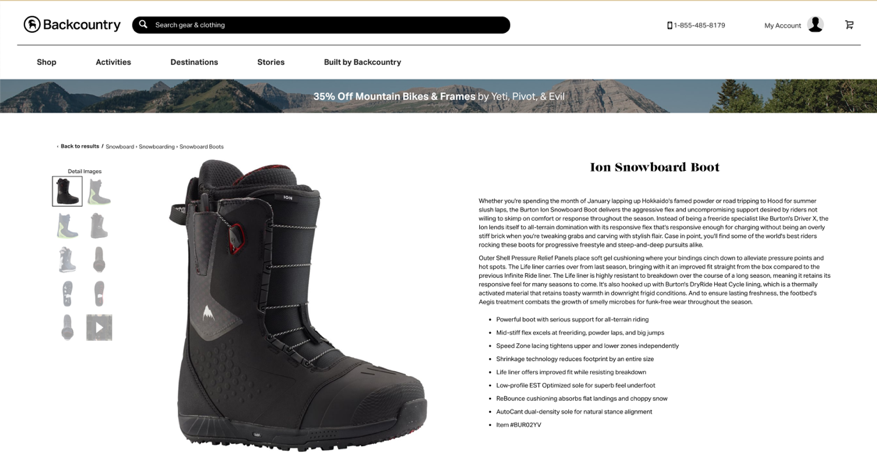
Hokkaido’s famed powder? Summer slush laps on Hood? Tweaking grabs? You may not know what all this means, but snowboarders do. Backcountry.com shows us how to speak to snowboarders about a snowboard boot.
People who shop for snowboard gear on Amazon, on the other hand, are more likely to be dabblers in the sport. Or parents buying for their kids. When selling the same products on Amazon, the story will need to be much more straightforward and written in accessible language with minimal insider references.
Key tactics
To optimize content per customer segment you should:
- Have a solid understanding of all your buying personas
- Be sure to align personas to each product, or product category
- Identify the channels in which each persona is most likely to shop
Finally, make sure your content creators have that information in front of them as they craft unique product stories tailored to each persona.
The Context: Incorporate purchase context into your product story
The easiest way to understand context is through the lens of seasonality: People buy hoodies all year long, but they buy them for different reasons at different times of year. But a pandemic is another very good reason to rewrite your product copy. So are sponsorships, collaborations, sporting events, concert seasons, celebrity snafus, holidays or any other trending cultural moment you can cleverly tie back to your products. Adapting your product stories to reflect customers’ changing purchase intent is critical to closing the sale.
“If we were selling product for outdoor lifestyle right now, at a time when people can’t leave their house, that would be inauthentic…it wouldn’t feel right.”
— Joe Kudlar, Vuori Founder and CEO
Cards Against Humanity gave us a famous example of agile product storytelling back in 2016. Following the Presidential election, CAH adjusted the story on their product page to capture what many of their customers were feeling at that particular moment in history.

Exceptional product copy not only raises conversion rates. It can raise brand awareness as well.
Depending on your political affiliation, the reference may or may not be funny. But you can’t argue with the results. Years later, thousands of influential blogs still mention— and link back to — this product page. The amount of organic traffic, not to mention sheer brand awareness, this product story generated for CAH throughout the years can’t be overstated. The clever copy also gives customers a reason to explore other product pages and check back to the site often.
But your product page doesn’t have to go viral to drive sales. Small Easter eggs strategically hidden throughout your product pages can increase page views, time on site and average order value as well.
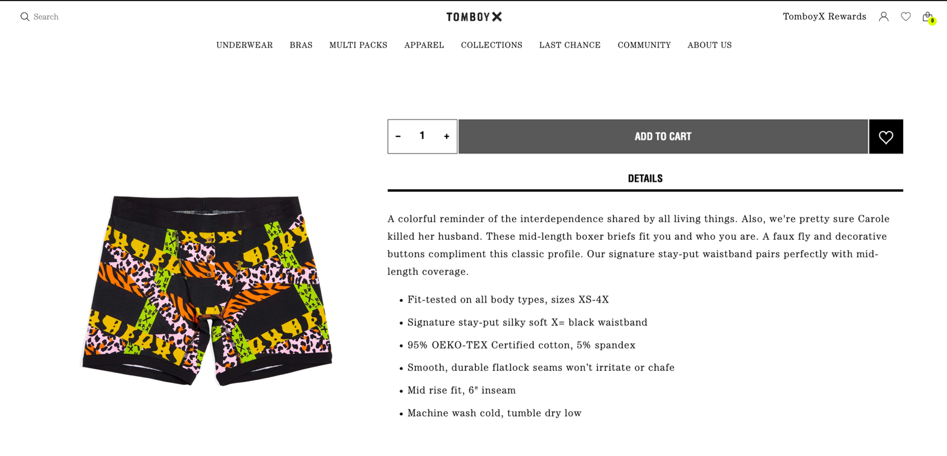 A sly reference to the cult Netflix documentary Tiger King in a TomboyX product story is a wink to shoppers that lets them know TomboyX is a company with a sense of humor, full of people that understand their customers because they’re pop-culture junkies just like them.
A sly reference to the cult Netflix documentary Tiger King in a TomboyX product story is a wink to shoppers that lets them know TomboyX is a company with a sense of humor, full of people that understand their customers because they’re pop-culture junkies just like them.Optimizing for context is more art than science. They key to success is to generate a few hypotheses about what events throughout the year will have an impact on your customers’ purchase behavior (Spring break for swimwear, for instance). Then start doing some A/B testing with differing product stories to prove out the ROI.
There are reoccurring contextual cues like seasonality, holidays and events that are easier to plan for. Then there are the unexpected moments, like an election, run-away hit documentary or a global pandemic that aren’t as easy to plan for. But it’s these unexpected cultural moments that have the power to change a brand’s destiny. You need to have the organizational trust and agility to take calculated risks on your product page. And, of course, the ability to measure the results.
The Product: Frame key features correctly to optimize conversion
Errors in product information are one of the most destructive results of set-it-and-forget-it product page content. Not only do errors supress your conversion rate by creating doubt at the moment of purchase; worse, they lead to costly returns and an erosion of customer trust.
With all the people and moving parts involved in the creation of a complex consumer product line, publishing error-free information to the product page is not an easy task. But with the right software and processes in place, you can easily detect and correct those errors once they appear.
And it’s not just errors that drag down sales and increase returns. You can have all the details right, but still not put those details together into a story that describes the product adequately to convert the consumer.
According to a well-known DTC retailer, one of the best-selling products sold on their site is The Exercise Dress. When analyzing customer reviews, 16% of all customers who bought the dress mentioned the internal bodysuit as their favorite feature. The bodysuit was far and away the most mentioned and most popular feature of the dress.
Surprisingly, the product story refers to the bodysuit incorrectly as a ‘built-in shorts liner.’ And it is described with little more emphasis or detail than a simple phone pocket.

Though the dress sells well, the brand would clearly convert far more shoppers if they were tracking the features customers were highlighting in their reviews and using those insights to craft more relevant product stories.
Most brands scrupulously track sales and return data. When sales dip or returns spike, that could signal errors in the product story. Unfortunately, that data rarely finds its way back to the team able to adapt the product story in real time. The result is lost sales, excess inventory and easily avoidable end-of-season markdowns.
Brands need to put a process in place that allows them to monitor their site for low performing product pages and alert the content team when changes to the product story are needed. In this way you can continuously optimize product content and recapture incremental revenue over the course of a season that would otherwise be lost to missing or flawed product information.
03 What should you do next?
Like the concept of ‘agile’ itself, agile product storytelling is an umbrella term for several iterative and incremental product content development approaches. There are nearly endless ways to optimize your product page content to be more relevant and useful at the moment of purchase— most of which will have a corresponding uplift in your conversion rate.
The key is to experiment and to find what product content works for your particular brand and your particular shoppers. Then keep experimenting. Higher conversion rates are a moving target and there is always room for improvement. What works for an outdoor brand won’t work for a fashion brand. And what works this season, might not work next season.
Here’s a quick overview of how to start experimenting to find the approach that works for your brand:
1. Start small and prove results
Identify a single collection or category where you can begin to prove out ROI. Starting small helps secure that early commitment from cross functional teams. A proven track record of success also makes further expansion easier
2. Socialize the APS concept and get ‘buy-in’
Once you determine the ROI, share those results key stakeholders. APS is a whole new way of approaching the product page that requires tight, cross-team collaboration. Content producers, product managers, marketing and ecommerce all need to be on board to achieve the best results.
3. Put a clear process in place
Once you’re confident in the power of agile product storytelling to produce bottom line results and you’ve convinced your team of its value, it’s time to start building out an ongoing process to continually monitor and optimize your stories across the entire year.
If you have a large product line and need to narrow your focus, begin with 1) your halo products and, 2) volume drivers. Halo products are those products that might not bring in significant revenue, but do drive brand awareness, credibility and social buzz. Volume drivers are those products that, based on the sheer numbers sold, make up a significant share of the company’s revenue. Concentrating your efforts on these two product types will have the greatest impact to your bottom line.
4. Incorporate product page content into your editorial calendar
Though most brands treat the product story on their PDP as a stand-alone piece of content, it’s more useful to think of it as the tail end of a long conversation the consumer has been having with your brand across multiple channels. By bringing the PDP content into your overall editorial calendar, you’ll ensure a more cohesive and trustworthy experience for the consumer all the way through the sales funnel.
The end goal of APS is to create a real time feedback loop with shoppers — using their own sales and return data, as well as their reviews and feedback — to help craft product stories throughout the year that ignite their interest and turn them into buyers. The result will be steadily rising conversion rates and higher traffic across all your product pages, which all add up to greater revenue. All with minimal upfront investment.

Why Talkoot produced this whitepaper
As a former content agency that helped world class consumer brands produce thousands of product page stories each year, we were frustrated at the difference we saw between the product descriptions we were able to generate at scale, given the set of tools and process available, and the product stories we were inspired by as consumers. We launched Talkoot to help brands bridge that gap and tell the kind of stories we were inspired by ourselves.
Talkoot makes publishing to your product pages as easy as posting to your social channels. It’s an agile product storytelling application that talks to all your back-end data systems, automates a mess of boring, repetitive tasks and publishes to your ecommerce site with a push of a button, so your team can focus on creating the kind of inspiring product stories that turn shoppers into buyers.
Once your product stories are live, Talkoot then monitors your site for low performing pages so you can continuously optimize product content in based on sales performance, customer feedback and return rates. The result is more engaged and loyal customers, higher sales, lower returns and a clear and measurable Return on Story.

